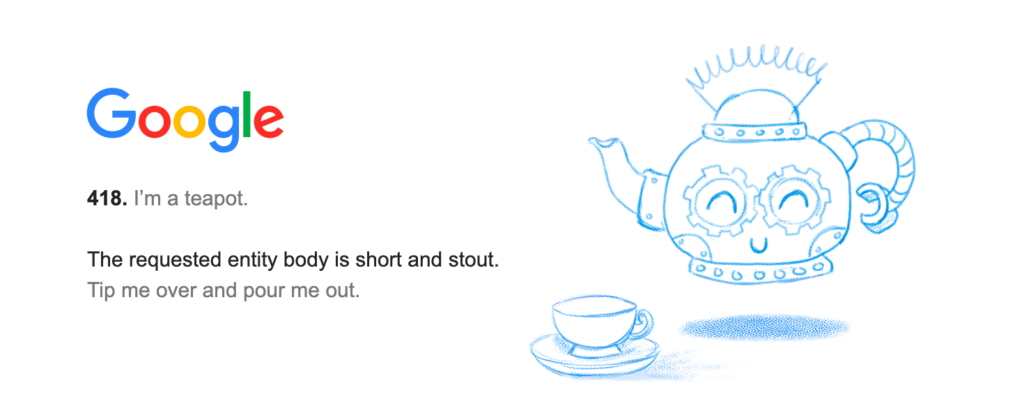- What is the HTTP Status Code 418?
- Who Created the HTTP 418 Status Code Error?
- HTTP 418 Status Code References
- HTTP Status Code 418 Example
- What are the Possible Causes for an HTTP 418 Status Code Error?
- Which HTTP Method is used with HTTP 418 Status Codes?
- What is the Related HTTP Response Header with 418 HTTP Status Code?
- What is the Browsers Compatibility of 418 HTTP Status Code?
- What are the Best Practices for Using the 418 Status Code?
- How to Handle 418 Error in JS?
- How to Test HTTP 418 Status Code in DevTools Browser in Chrome?
- How to Test 418 HTTP Status Code on Postman?
- Conclusion
Welcome to the quirky world of web protocols, where not all is as serious as it seems! At Reliqus Consulting, we are always on the lookout to explore the fascinating corners of technology, shedding light on its utility and its capacity for humor.
Today, we’re delving into one of the internet’s most distinctive and amusing features: the HTTP 418 status code, affectionately known as ‘I’m a teapot.’ It’s a unique quirk that’s sure to pique your interest!
While HTTP status codes are typically straightforward indicators of whether your web requests are successful, encountering a 418 is more likely to brew curiosity than typical server responses.
In this blog post, we will delve into the world of HTTP 418 error, also known as the 418 I’m a Teapot Error, and explore its origins, meaning, and potential uses. By grasping this unique status code, you’ll be better prepared to navigate the web development landscape.
What is the HTTP Status Code 418?
The 418 HTTP Response Status Code is a unique client error response code. It’s a unique way for the server to say, ‘I recognize your request, but I’m a teapot, so I can’t comply.’ This code indicates the server’s limitations, such as a teapot not being designed to brew coffee.

Essentially, this non-standard, humorous status code conveys that the server cannot brew coffee, as it is not designed to do so. If a device designed to be both a coffee and tea maker is temporarily unable to make coffee, it should return a 503 error code, indicating service unavailability.
Some developers choose to employ this code for requests they prefer not to handle, such as automated queries. This not only adds a dash of humor and personality to otherwise standard error responses but also serves as a practical way to manage certain types of requests.
Source: RFC2324 Section 2.3.2
Who Created the HTTP 418 Status Code Error?
The HTTP 418 “I’m a Teapot” status code was created by April King, an Internet Engineering Task Force (IETF) member. This status code was proposed as part of an April Fools’ Day joke in 1998. The humorous code indicates that the server is a teapot and cannot brew coffee.
HTTP 418 Status Code References
Go HTTP Status Constant http.StatusTeapot
Symfony HTTP Status Constant Response::HTTP_I_AM_A_TEAPOT
.NET StatusCodes.Status418ImATeapot
Rust http::StatusCode::IM_A_TEAPOT
Python3.5+ http.HTTPStatus.IM_A_TEAPOT
Angular @angular/common/http/HttpStatusCode.ImATeapot
HTTP Status Code 418 Example
The following is an example request and response for the 418 I’m a Teapot Error:
Request
GET /coffee HTTP/1.1
Host: example.com
Response
HTTP/1.1 418 I’m a teapot
Date: Wed, 16 Mar 2023 12:00:00 GMT
Connection: close
Content-Type: text/html
<!DOCTYPE html>
<html>
<head>
<title>I’m a teapot</title>
</head>
<body>
<h1>I’m a teapot</h1>
<p>This server is a teapot, and it cannot brew coffee.</p>
</body>
</html>
418 is a humorous error code indicating that the server cannot brew coffee because it is a teapot. As far as SEO and clients are concerned, it should not be taken seriously and cannot be expected to make a real impact.
What are the Possible Causes for an HTTP 418 Status Code Error?
A 418 error, humorously known as “I’m a teapot,” is not a standard HTTP status code and is typically used for comedic or educational purposes rather than indicating a severe issue.
Here are the possible causes for encountering a 418 HTTP Response Status Code:
- Server Misconfiguration: The server may behave unexpectedly due to misconfiguration, triggering the 418 HTTP error.
- API Issues: Poorly configured APIs or miscommunication can lead to encountering Error 418, especially when sending incorrect requests. Checking API documentation and ensuring correct requests can help resolve this issue.
- Developer Humor: Some developers intentionally include Error 418 in their code as a joke or to indicate specific types of incorrect requests. In such cases, checking the application code, especially error-handling logic, is essential.
- Unusual Server Behavior: Encountering a 418 error might indicate unexpected server behavior, possibly due to unique configurations or third-party libraries using this status code for specific cases.
- Client-Side Errors: The 418 error falls within the 4xx range of HTTP status codes, typically indicating client-side errors. However, it is not meant to be treated as a serious error and is not part of the official HTTP errors.
- Internet Culture: Despite its origins as an April Fools’ Day joke in 1998, the 418 error has become a humorous piece of trivia among web developers and is sometimes used as an easter egg in web services and APIs.
Explore our comprehensive guide to HTTP status codes to learn more about them and their implications. This guide covers various codes and their typical uses in web communications. It provides a deeper understanding of how errors like 418 fit into the broader web development landscape.
Remember, encountering a 418 error is a rare occurrence in regular web communications and is more of a novelty than a critical issue. It’s important to investigate the specific context of the error and address any underlying problems accordingly, but there’s no need to panic.
Which HTTP Method is used with HTTP 418 Status Codes?
Interestingly, only one HTTP Method is specifically associated with the 418 HTTP Response Status Code: the TRACE method.
The TRACE method is unique because it lets the client see what changes or additions have been made to the request message as it passes through the server. The message body contains the server’s response.
This functionality is handy for debugging purposes.
What is the Related HTTP Response Header with 418 HTTP Status Code?
A related HTTP response header is associated with HTTP Status Code 418, the 417 HTTP Status Code. Both of these codes represent client error responses.
The 417 HTTP Status Code expresses that the server cannot meet the expectations outlined in the Expect request-header field.
This interplay between the 418 I’m a Teapot Error and the 417 status code illustrates the range of humorous yet meaningful communications that can occur between a client and server, particularly highlighting the unique and whimsical nature of the 418 Status Code “I’m a teapot.”
What is the Browsers Compatibility of 418 HTTP Status Code?
The HTTP 418 Status Code is compatible with all major browsers, including Chrome, Edge, Firefox, Internet Explorer, Opera, Safari, and Web View Android.
What are the Best Practices for Using the 418 Status Code?
When considering the implementation of the HTTP 418 Status Code, it’s essential to approach it with a sense of responsibility and context-awareness. Here are some best practices to ensure its use is appropriate and effective: –
- Remember that the 418 I’m a Teapot Error is primarily an easter egg from the Hyper Text Coffee Pot Control Protocol and not meant for serious use in production environments. Its existence is more about internet culture and humor than about practical functionality.
- Utilize the 418 HTTP Response Status Code only in contexts where it will be understood and appreciated. It’s crucial to ensure users are familiar with this internet lore.
- If the 418 HTTP Status Code is used within APIs or web services, it is essential to document its meaning clearly and thoroughly. This documentation should explain the error’s background, intended use, and any humorous intent behind its implementation.
- Employ the 418 status code sparingly and with caution. It should fit your audience’s tone and expectations. Overuse or misuse can dilute its novelty and lead to misunderstanding.
By adhering to these guidelines, developers, and webmasters can ensure that the quirky nature of the 418 HTTP Response Status Code enhances user experience without causing confusion or errors in communication.
How to Handle 418 Error in JS?
Handling a 418 code error in JavaScript means checking the response status code during HTTP requests. For instance, when using the Fetch API, you might have code like this:
fetch(”)
.then(response => {
if (response.status === 418) {
console.log(“I’m a teapot! The server refuses to brew coffee.”);
} else {
// handle other statuses or process response data
}
})
.catch(error => console.error(‘Error:’, error));
This snippet exemplifies error handling by inspecting the response’s status and logging a whimsical message upon encountering the HTTP 418 error code, enhancing the debugging process with humor.
How to Test HTTP 418 Status Code in DevTools Browser in Chrome?
- Open Chrome DevTools by either right-clicking on any web page and selecting “Inspect” or by using the shortcut keys: Ctrl+Shift+I (Windows/Linux) or Cmd+Option+I (Mac).
- Navigate to the “Network” tab within DevTools.
- Trigger a request to an endpoint that returns the 418 HTTP Response Status Code by reloading the page or using the website’s UI to make the request.
- Please search for the made request in the Network log and click on it. You can view detailed information, including the HTTP Status Code 418 and the whimsical “I’m a teapot” response details.
How to Test 418 HTTP Status Code on Postman?
- Set up a mock server or Postman API to return a 418 status code.
- Create a new request in Postman.
- Set the request type to either GET or POST, depending on what you’re testing.
- Input the URL for the server or endpoint designed to elicit the HTTP 418 status code response.
- Hit the send button and watch the response section. Look for the 418 status code. It’s a quirky “I’m a teapot” message to confirm that your setup is working correctly.
Conclusion
The 418 HTTP Response Status Codes were created by developers as a lighthearted joke, not meant to signal any real problems with your application or server.
While encountering this HTTP 418 Status Code may raise eyebrows and prompt a closer look at server requests, it’s generally benign. Its presence can serve as a quirky reminder for developers to check for any unusual issues in their applications, codebase, server configurations, or API interactions.
Thus, while it’s all good fun, a surprise encounter with this error could be a nudge to ensure everything is running smoothly.
FAQ
Here are some frequently asked questions about the HTTP 418 status code:
What Does a JSP Status Code 418 Imply?
A JSP status code 418 implies a similar humorous or unusual server behavior rather than a fundamental error.
Can I use the HTTP 418 Status Code in Production?
Using the 418 HTTP status code in production environments is technically possible but not recommended due to its non-standard and humorous nature. While some web services and APIs may use it as an Easter egg or humorously indicate a misdirected request, it is not standard or considered a best practice.
Are There Any Real-World Uses of the 418 Status Code?
HTTP Status Code 418’s real-world uses are limited, with some websites and web services implementing it as a unique Easter egg within the tech community.
How do Browsers Handle Receiving a 418 Status Code?
Browsers handle receiving a 418 status code by treating it like any other unexpected HTTP status, displaying the server’s response body or a default error message.
Do all Web Servers Recognize the 418 HTTP Status Code?
Web servers recognize the 418 HTTP Response Status Code differently, as not all servers have built-in support. Its implementation and handling depend on the server software and configuration, making its recognition not universal across all web servers.
